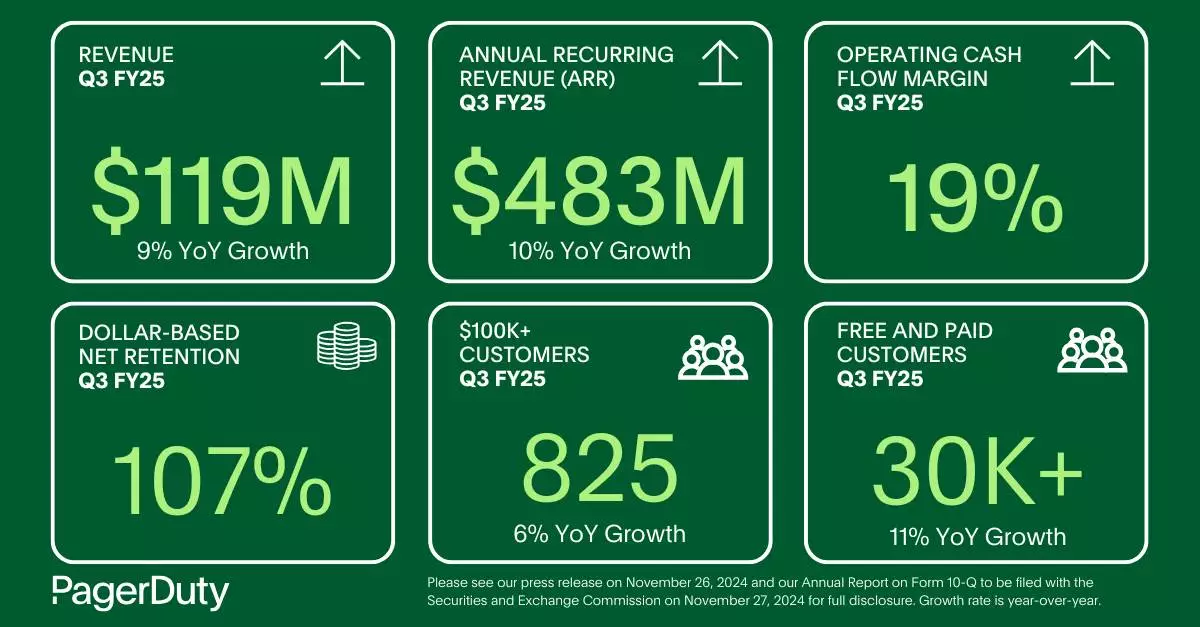SAN FRANCISCO--(BUSINESS WIRE)--Nov 26, 2024--
PagerDuty, Inc. (NYSE:PD), a leader in digital operations management, today announced financial results for the third quarter of fiscal 2025, ended October 31, 2024.
This press release features multimedia. View the full release here: https://www.businesswire.com/news/home/20241126811639/en/
“PagerDuty delivered a solid quarter with revenue and non-GAAP operating income results well above third quarter guidance ranges with annual recurring revenue increasing to $483 million, growing 10% year-over-year,” said Chairperson and CEO, Jennifer Tejada. “Consistent performance over the past four quarters has led to stabilization across all business segments, and along with improving leading indicators, positions the business on a strong upward trajectory.”
Third Quarter Fiscal 2025 Financial Highlights
The section titled “Non-GAAP Financial Measures” below contains a description of the non-GAAP financial measures and reconciliations between GAAP and non-GAAP financial information.
Third Quarter and Recent Highlights
Financial Outlook
For the fourth quarter of fiscal 2025, PagerDuty currently expects:
For the full fiscal year 2025, PagerDuty currently expects:
These statements are forward-looking and actual results may differ materially. Please refer to the section titled "Forward-Looking Statements" below for information on the factors that could cause our actual results to differ materially from these forward-looking statements.
PagerDuty has not reconciled forward-looking net loss per share attributable to PagerDuty, Inc. common stock holders to forward-looking non-GAAP net income per share attributable to PagerDuty, Inc. common stockholders because certain items are out of PagerDuty's control or cannot be reasonably predicted. Accordingly, such reconciliation is not available without unreasonable effort.
Conference Call Information
PagerDuty will host a conference call and live webcast (Zoom meeting ID 975 4160 6140) for analysts and investors at 2:00 p.m. Pacific Time on November 26, 2024. For audio only, the dial-in number 1-312-626-6799 may be used. This news release with the financial results will be accessible from PagerDuty’s website at investor.pagerduty.com prior to the conference call. A live webcast of the conference call will be accessible from the PagerDuty investor relations website at investor.pagerduty.com.
Supplemental Financial and Other Information
Supplemental financial and other information can be accessed through PagerDuty’s investor relations website at investor.pagerduty.com. PagerDuty uses the investor relations section on its website as the means of complying with its disclosure obligations under Regulation FD. Accordingly, we recommend that investors monitor PagerDuty’s investor relations website in addition to following PagerDuty’s press releases, SEC filings, social media, including PagerDuty’s LinkedIn account ( https://www.linkedin.com/company/482819 ), X (formerly Twitter) account @pagerduty, the X account @jenntejada and Facebook page (facebook.com/pagerduty), and public conference calls and webcasts.
Forward-Looking Statements
This press release contains “forward-looking statements” within the meaning of the “safe harbor” provisions of the Private Securities Litigation Reform Act of 1995, including but not limited to, statements regarding our future financial performance and outlook, and market positioning. Words such as “expect,” “extend,” “anticipate,” “should,” “believe,” “hope,” “target,” “project,” “accelerate,” “goals,” “estimate,” “potential,” “predict,” “may,” “will,” “might,” “could,” “intend,” “shall,” and variations of these terms or the negative of these terms and similar expressions are intended to identify these forward-looking statements. Forward-looking statements are subject to a number of risks and uncertainties, many of which involve factors or circumstances that are beyond our control. Our actual results could differ materially from those stated or implied in forward-looking statements due to a number of factors, including but not limited to, risks and other factors detailed in our Annual Report on Form 10-K/A filed with the Securities and Exchange Commission (SEC) on March 18, 2024. Additional information will be made available in our Quarterly Report on Form 10-Q for the quarter ended October 31, 2024 and other filings and reports that we may file from time to time with the SEC. In particular, the following risks and uncertainties, among others, could cause results to differ materially from those expressed or implied by such forward-looking statements: the effect of unfavorable conditions in our industry or the global economy, or reductions in information technology spending on our business and results of operations; our ability to achieve and maintain future profitability; our ability to attract new customers and retain and sell additional functionality and services to our existing customers; our ability to sustain and manage our growth; our dependence on revenue from a single product; our ability to compete effectively in an increasingly competitive market; and general global market, political, economic, and business conditions.
Past performance is not necessarily indicative of future results. The forward-looking statements included in this press release represent our views as of the date of this press release. We anticipate that subsequent events and developments will cause our views to change. We undertake no intention or obligation to update or revise any forward-looking statements, whether as a result of new information, future events or otherwise. These forward-looking statements should not be relied upon as representing our views as of any date subsequent to the date of this press release.
About PagerDuty, Inc.
PagerDuty, Inc. (NYSE:PD) is a global leader in digital operations management, enabling customers to achieve operational efficiency at scale with the PagerDuty Operations Cloud. The PagerDuty Operations Cloud combines AIOps, Automation, Customer Service Operations and Incident Management with a powerful generative AI assistant to create a flexible, resilient and scalable platform to increase innovation velocity, grow revenue, reduce cost, and mitigate the risk of operational failure. Half of the Fortune 500 and nearly 70% of the Fortune 100 rely on PagerDuty as essential infrastructure for the modern enterprise. To learn more and try PagerDuty for free, visit www.pagerduty.com.
The PagerDuty Operations Cloud
The PagerDuty Operations Cloud is the platform for mission-critical, time-critical operations work in the modern enterprise. Through the power of AI and automation, it detects and diagnoses disruptive events, mobilizes the right team members to respond, and streamlines infrastructure and workflows across your digital operations. The Operations Cloud is essential infrastructure for revolutionizing digital operations to compete and win as a modern digital business.
Non-GAAP Financial Measures
This press release and the accompanying tables contain the following non-GAAP financial measures: non-GAAP gross profit, non-GAAP gross margin, non-GAAP research and development, non-GAAP sales and marketing, non-GAAP general and administrative, non-GAAP operating income, non-GAAP operating margin, non-GAAP net income attributable to PagerDuty, Inc. common stockholders, non-GAAP net income per share attributable to PagerDuty, Inc. common stockholders, free cash flow, and free cash flow margin.
PagerDuty believes that non-GAAP financial measures, when taken collectively, may be helpful to investors because they provide consistency and comparability with past financial performance and can assist in comparisons with other companies, some of which use similar non-GAAP financial measures to supplement their GAAP results. The non-GAAP financial information is presented for supplemental informational purposes only, should not be considered a substitute for financial information presented in accordance with GAAP, and may be different from similarly-titled non-GAAP measures used by other companies.
The principal limitation of these non-GAAP financial measures is that they exclude significant expenses and income that are required by GAAP to be recorded in PagerDuty’s financial statements. In addition, they are subject to inherent limitations as they reflect the exercise of judgment by PagerDuty’s management about which expenses and income are excluded or included in determining these non-GAAP financial measures. A reconciliation is provided below for each historical non-GAAP financial measure to the most directly comparable financial measure presented in accordance with GAAP.
Specifically, PagerDuty excludes the following from its historical and prospective non-GAAP financial measures, as applicable:
Stock-based compensation: PagerDuty utilizes stock-based compensation to attract and retain employees. It is principally aimed at aligning their interests with those of its stockholders and at long-term retention, rather than to address operational performance for any particular period. As a result, stock-based compensation expenses vary for reasons that are generally unrelated to financial and operational performance in any particular period.
Employer taxes related to employee stock transactions: PagerDuty views the amount of employer taxes related to its employee stock transactions as an expense that is dependent on its stock price, employee exercise and other award disposition activity, and other factors that are beyond PagerDuty’s control. As a result, employer taxes related to employee stock transactions vary for reasons that are generally unrelated to financial and operational performance in any particular period.
Amortization of acquired intangible assets: PagerDuty views amortization of acquired intangible assets as items arising from pre-acquisition activities determined at the time of an acquisition. While these intangible assets are evaluated for impairment regularly, amortization of the cost of purchased intangibles is an expense that is not typically affected by operations during any particular period.
Acquisition-related expenses: PagerDuty views acquisition-related expenses, such as transaction costs, acquisition-related retention payments, and acquisition-related asset impairment, as events that are not necessarily reflective of operational performance during a period. In particular, PagerDuty believes the consideration of measures that exclude such expenses can assist in the comparison of operational performance in different periods which may or may not include such expenses.
Amortization of debt issuance costs: The imputed interest rates of the Company's convertible senior notes (the "2025 Notes" and the "2028 Notes" or, collectively, the "Notes") was approximately 1.91% for the 2025 Notes and 2.13% for the 2028 Notes. This is a result of the debt issuance costs, which reduce the carrying value of the convertible debt instruments. The debt issuance costs are amortized as interest expense. The expense for the amortization of the debt issuance costs is a non-cash item, and we believe the exclusion of this interest expense will provide for a more useful comparison of our operational performance in different periods.
Restructuring costs: PagerDuty views restructuring costs, such as employee severance-related costs and real estate impairment costs, as events that are not necessarily reflective of operational performance during a period. In particular, PagerDuty believes the consideration of measures that exclude such expenses can assist in the comparison of operational performance in different periods which may or may not include such expenses.
Gains (or losses) on partial extinguishment of convertible senior notes: PagerDuty views gains (or losses) on partial extinguishment of debt as events that are not necessarily reflective of operational performance during a period. PagerDuty believes that the consideration of measures that exclude such gain (or loss) impact can assist in the comparison of operational performance in different periods which may or may not include such gains (or losses).
Adjustment attributable to redeemable non-controlling interest: PagerDuty adjusts the value of redeemable non-controlling interest of its joint venture PagerDuty K.K. according to the operating agreement. PagerDuty believes this adjustment is not reflective of operational performance during a period and exclusion of such adjustments can assist in comparison of operational performance in different periods.
Income tax effects and adjustments: Based on PagerDuty's financial outlook for fiscal 2025, PagerDuty is utilizing a projected non-GAAP tax rate of 23% in order to provide better consistency across the interim reporting periods by eliminating the impact of non-recurring and period specific items, which can vary in size and frequency. PagerDuty's estimated tax rate on non-GAAP income is determined annually and may be adjusted during the year to take into account events or trends that PagerDuty believes materially impact the estimated annual rate including, but not limited to, significant changes resulting from tax legislation, material changes in the geographic mix of revenue and expenses and other significant events.
Non-GAAP gross profit and non-GAAP gross margin
We define non-GAAP gross profit as gross profit excluding the following expenses typically included in cost of revenue: stock-based compensation expense, employer taxes related to employee stock transactions, amortization of acquired intangible assets, and restructuring costs. We define non-GAAP gross margin as non-GAAP gross profit as a percentage of revenue.
Non-GAAP operating expenses
We define non-GAAP operating expenses as operating expenses excluding stock-based compensation expense, employer taxes related to employee stock transactions, amortization of acquired intangible assets, acquisition-related expenses, which include transaction costs, acquisition-related retention payments, and asset impairment, and restructuring costs which are not necessarily reflective of operational performance during a given period.
Non-GAAP operating income and non-GAAP operating margin
We define non-GAAP operating income as loss from operations excluding stock-based compensation expense, employer taxes related to employee stock transactions, amortization of acquired intangible assets, acquisition-related expenses, which include transaction costs, acquisition-related retention payments, and asset impairment, and restructuring costs which are not necessarily reflective of operational performance during a given period. We define non-GAAP operating margin as non-GAAP operating income as a percentage of revenue.
Non-GAAP net income attributable to PagerDuty, Inc. common stockholders
We define non-GAAP net income attributable to PagerDuty, Inc. common stockholders as net loss attributable to PagerDuty, Inc. common stockholders excluding stock-based compensation expense, employer taxes related to employee stock transactions, amortization of debt issuance costs, amortization of acquired intangible assets, acquisition-related expenses, which include transaction costs, acquisition-related retention payments and asset impairment, restructuring costs, adjustment attributable to redeemable non-controlling interest, and income tax adjustments, which are not necessarily reflective of operational performance during a given period.
Non-GAAP net income per share, basic and diluted
We define non-GAAP net income per share, basic as non-GAAP net income attributable to PagerDuty, Inc. common stockholders divided by weighted average shares outstanding at the end of the reporting period. We define non-GAAP net income per share, diluted as non-GAAP net income attributable to PagerDuty, Inc. common stockholders divided by weighted average diluted shares outstanding at the end of the reporting period.
Free cash flow and free cash flow margin
We define free cash flow as net cash provided by operating activities, less cash used for purchases of property and equipment and capitalization of internal-use software costs. We define free cash flow margin as free cash flow as a percentage of revenue. In addition to the reasons stated above, we believe that free cash flow is useful to investors as a liquidity measure because it measures our ability to generate or use cash in excess of our capital investments in property and equipment in order to enhance the strength of our balance sheet and further invest in our business and potential strategic initiatives. A limitation of the utility of free cash flow as a measure of our liquidity is that it does not represent the total increase or decrease in our cash balance for the period. We use free cash flow in conjunction with traditional U.S. GAAP measures as part of our overall assessment of our liquidity, including the preparation of our annual operating budget and quarterly forecasts and to evaluate the effectiveness of our business strategies. There are a number of limitations related to the use of free cash flow as compared to net cash provided by operating activities, including that free cash flow includes capital expenditures, the benefits of which are realized in periods subsequent to those when expenditures are made.
PagerDuty encourages investors to review the related GAAP financial measures and the reconciliation of these non-GAAP financial measures to their most directly comparable GAAP financial measures, which it includes in press releases announcing quarterly financial results, including this press release, and not to rely on any single financial measure to evaluate PagerDuty’s business.
Please see the reconciliation tables at the end of this release for the reconciliation of non-GAAP financial measures to their most-comparable GAAP financial measures.


(Graphic: Business Wire)

















